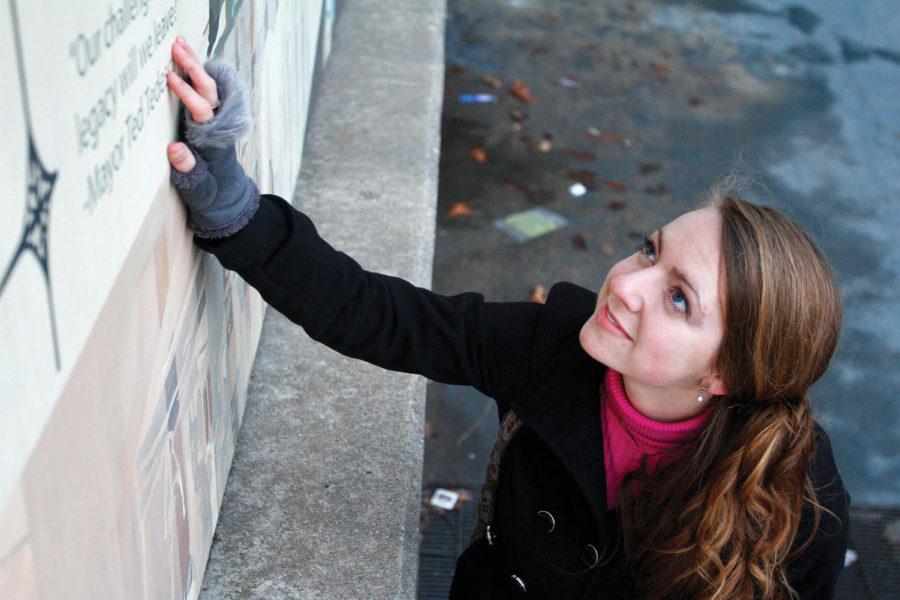FOuR WALLS helps local communities as well as those abroad
Photo: Huiling Wu/ Iowa State Daily
Hannah Rosenthal, graduate in architecture, will hold an exhibition in the Memorial Union during VEISHEA.
February 19, 2013
Is it possible that art could potentially raise money and give back to not only the community of Ames but also to communities in need overseas? That is the question Hannah Rosenthal, master of science in architecture candidate, has decided to challenge with her senior thesis project.
Rosenthal partnered up with Design Across Boundaries, a student-run organization on campus, to plan this project. The goal is to have students, faculty or anyone interested create artwork.
This project’s title FOuR WALLS is a pun, said Rosenthal. It has to do with what equitable shelter means to each person and has to do with the fact that some people don’t have four walls and a roof over their head.
Rosenthal explained that the u is emphasized to show the importance for you as an individual, student body and community.
The pieces of artwork are to be auctioned off the week of Veishea. This money will then be donated to nonprofit organizations in both India and in Ames.
In Ames, the money will be put towards homeless shelters to use however it is deemed necessary. The money donated to India, however, will take on a slightly different focus.
Rosenthal traveled to India in 2011 to intern with Engineering Ministries International. She said Engineering Ministries International is a company of architects and engineers that design structures in hope that their designs eventually are built.
The company offers an internship program that relies on a lot of American and English students. Rosenthal said Engineering Ministries International wants to expand and have more Indian intern students, but the problem is that in India’s culture, it is frowned upon to volunteer time and talent free of charge.
“Don’t get me wrong; there are a lot of people in India doing great things and volunteering, but if you’re an architect, it’s very expected that you’ll go make a lot of money, and that you won’t donate your services to the poor,” Rosenthal said. “So Indian students that do want to serve nonprofit organizations face a little bit of that cultural resistance, particularly from their families.”
Rosenthal said these are the experiences that inspired a big part of this project. This money would help the American architecture firm hire Indian students to give them the opportunity to do social projects without being frowned upon.
“I felt an overwhelming sense of gratitude for what I’ve been given, not even what I’ve earned, because there are so many things in our lives that we have just been handed,” Rosenthal said.
Rosenthal explained that the reason behind her project is to show and educate people on what kind of poverty not only takes place in India, but in every culture, including Ames.
“If I can teach while helping my collegues and Indian students, then why not?” Rosenthal said.
Though Rosenthal headed this project, she said it has turned into a group project. Rosenthal has networked with churches, artists and architecture firms.
“[Design Across Boundaries is a student organization that ties in a lot of different disciplines and a lot of people from different majors in order to work to develop an understanding of humanitarian issues, such as housing,” said Zach Sunderland, senior in architecture and president of Design Across Boundaries. “[Design Across Boundaries] also focuses on and works on projects that help communities in need.”
The organizations vision is to serve communities in need both locally and abroad. Both Rosenthal and Sunderland agreed to pair up on this project.
The group has teamed up with Rosenthal to set up the event, coordinate volunteers and possibly even design an instillation piece for the event.
“We always want to advocate for the people that are in need so we can bring attention as well as resources to them,” Sunderland said. “We also want to educate the people in our own communities so they can have a bigger vision of the world and be more informed.”
Rosenthal said that she not only sees an importance in fundraising for communities in need, but she also said she wants to challenge the designers for the project, mainly the architects. She hopes this project will spark people’s interest in what the phrase equitable shelter is and what it means to design equitable.
Rosenthal hopes this will challenge societies expectations of artists.
“Artists and designers make the difference,” Rosenthal said, “There’s a change that needs to happen in the world and artists have a role in that. We need to own it, and society needs to recognize it as well as expect it from us.”







